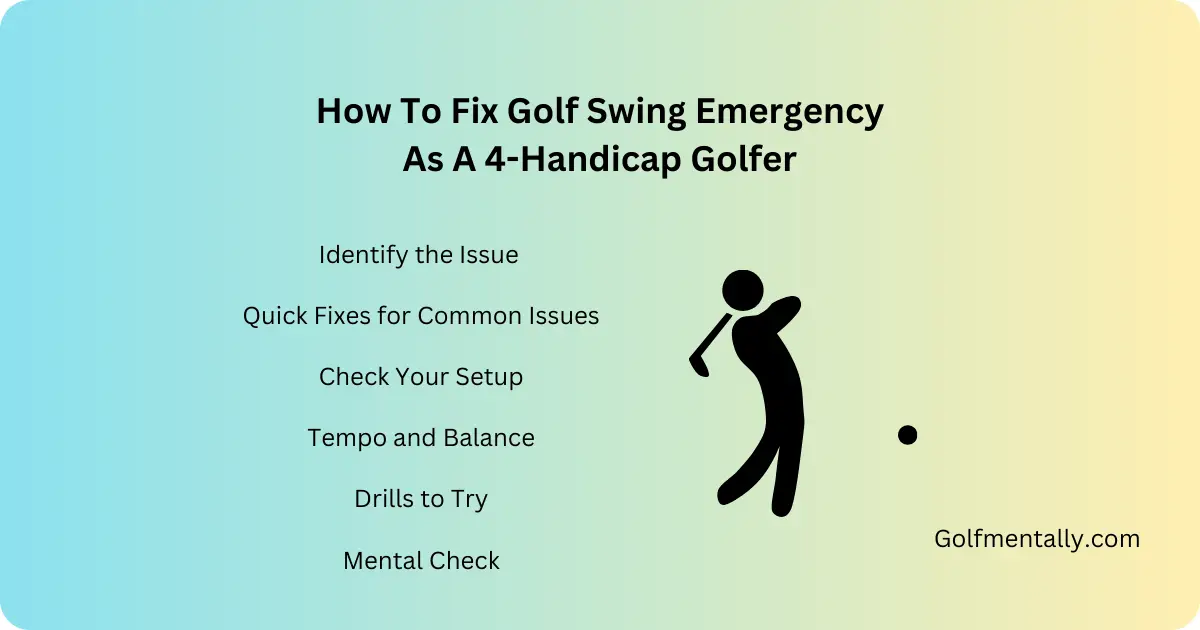How To Fix Golf Swing Emergency As A 4-Handicap Golfer? As a 4-handicap golfer, you’ve developed a good level of skill. However, you might face a golf swing emergency at any time. This could be a sudden slice, a loss of distance, or just feeling like your swing isn’t working. These situations can be frustrating, but don’t worry! In this guide, we’ll discuss effective ways to fix your swing problems quickly.
The Swing of a 4-Handicap Golfer
Understanding your swing is key. A 4-handicap player usually has a solid grip on swing mechanics. However, small mistakes can lead to big problems.
Common Problems for Skilled Players
- Swing Plane Issues: Keeping the right swing plane is vital for consistent shots. Even good players can struggle with this, leading to slices or hooks.
- Wrist Position: If your wrist isn’t positioned correctly at the top of your backswing, it can cause inconsistent shots.
- Alignment Problems: Proper alignment is essential. Misalignment can force you to make adjustments during your swing, affecting your shot.
- Grip Pressure: Holding the club too tightly can limit your swing. A relaxed grip is crucial for a smooth stroke.
- Tempo and Rhythm: A steady tempo is important. If your rhythm is off, it can lead to an inconsistent swing.
- Over the Top Swing: This common error results in an out-to-in swing path, causing slices or pulls.
Quick Fixes for Swing Emergencies
If you find yourself in a swing emergency, try these quick fixes:
1. Check Your Fundamentals
When you experience problems, take a moment to reset your basics:
- Grip: Ensure your grip is neutral, neither too strong nor too weak.
- Posture: Keep a slight bend in your knees and maintain a good spine angle.
- Ball Position: Adjust the ball’s position according to the club you’re using.
2. Focus on Your Tempo
A disrupted tempo can impact your swing. To regain your rhythm:
- Count during your swing: “1” for backswing, “2” for downswing, and “3” for follow-through.
- Use a metronome app to practice a consistent tempo.
3. Shorten Your Backswing
If you’re having control issues, try shortening your backswing to three-quarters of its length. This can help you maintain balance and control.
4. Use Technology for Feedback
Consider using tools like HackMotion for real-time feedback on wrist position. This can help you make quick adjustments.
5. Practice the “Pause Drill”
To fix over-the-top swings or rhythm issues:
- Take your usual backswing.
- Pause briefly at the top.
- Start your downswing slowly, focusing on bringing the club down smoothly.
- Accelerate through impact.
This drill encourages a more natural swing path.
Advanced Techniques for 4-Handicap Players
As a skilled golfer, you can use more advanced techniques to handle swing emergencies:
1. Learn Shot Shaping
Mastering shot shaping can help you manage a persistent slice or hook:
- For a draw, slightly strengthen your grip and focus on an inside-out swing path.
- For a fade, weaken your grip and feel like you’re cutting across the ball.
2. Practice Swing Variability
Add different swing types to your practice sessions. This can help you adapt during emergencies:
- Work on hitting high, medium, and low shots.
- Adjust your swing speed to practice control.
3. Focus on Your Mental Game
Swing emergencies are often as much about your mindset as your technique. Here are a few strategies:
- Visualize your desired shot before you take it.
- Use deep breathing to stay calm between shots.
- Develop a pre-shot routine to help you reset mentally.
Using Technology and Data
In today’s golf world, technology can help you tackle swing emergencies:
- Video Analysis: Record your swing on your phone. Analyzing it can help you spot issues quickly.
- Launch Monitors: These devices provide instant data on your shots, helping you make adjustments as needed.
- Golf Performance Apps: Use apps like GolfMetrics to track your performance. This can help you identify areas to improve.
Preventing Swing Emergencies
While quick fixes are useful, preventing emergencies is just as important for 4-handicap golfers:
- Stay Fit: Regular exercises improve flexibility and strength, helping you maintain a consistent swing.
- Practice Regularly: Spend time on the range focusing on technique and strategy to reinforce good habits.
- Check Your Equipment: Regularly inspect your clubs. Small changes can affect your swing.
- Consider Professional Lessons: Even skilled golfers benefit from occasional lessons. A fresh perspective can help you identify potential issues.
Golf Swing Emergency Can I Fix This 4 Handicap?
If you’re a 4 handicap golfer facing a sudden swing issue, start by figuring out what’s going wrong. Is the ball flying inconsistently (slicing, hooking, pushing, or pulling)? Are you hitting it thin, fat, or off-center? Or does your swing just feel out of sync?
For a slice, check if your grip is too weak and try swinging more from the inside. If you’re hooking, your grip might be too strong, so aim for a more neutral release. Struggling with fat shots? Stay steady over the ball and avoid swaying. For thin shots, keep your spine angle consistent and don’t rise up during the swing.
Make sure your setup is solid—check your alignment, ball position, and posture, as even small mistakes here can cause big problems. Focus on keeping your swing smooth and balanced, especially during the backswing and transition.
Practice drills like half-swings, pausing at the top of your backswing, or using an alignment stick to improve your path. Don’t let frustration take over—take a mental break and trust your skills.
If the problem doesn’t go away, record your swing or get a quick lesson from a pro to find the fix you need.
Conclusion
Golf swing emergencies can happen to anyone, even 4-handicap golfers. By understanding common problems and using quick fixes, you can get back on track. Stay calm, trust your skills, and make small adjustments. With these strategies, you’ll be ready to handle any swing emergency and maintain your low-handicap status. Keep practicing, stay focused, and enjoy your golfing journey!
FAQs
What should I do if my golf swing feels off?
Take a moment to check your grip, posture, and alignment. A quick reset of your fundamentals can often help.
How can I fix a slice in my golf swing?
Strengthen your grip and focus on an inside-out swing path to help promote a draw instead of a slice.
What are common swing faults for low-handicap golfers?
Common faults include swing plane issues, wrist position problems, alignment errors, and over-the-top swings.
How can I improve my swing tempo?
Practice counting during your swing or use a metronome app to help maintain a steady rhythm.
What is the “Pause Drill”?
The Pause Drill involves taking your normal backswing, pausing briefly at the top, then starting your downswing slowly to encourage better timing and path.
How important is grip pressure in my swing?
Proper grip pressure is crucial; holding the club too tightly can restrict your swing and lead to inconsistent shots.
Can technology help improve my swing?
Yes, tools like video analysis and launch monitors can provide valuable feedback to help you make adjustments.
What exercises can help my golf swing?
Golf-specific exercises focusing on flexibility, core strength, and balance can greatly enhance your swing performance.
How can I manage my mental game during a swing emergency?
Use visualization techniques, practice deep breathing, and have a pre-shot routine to stay calm and focused.
Should I consider professional lessons even as a low-handicap player?
Yes, professional lessons can provide fresh insights and help identify any weaknesses in your game, keeping you at peak performance.

James Smith is the author of a website called Golf Mentally. He believes that golf is as much about thinking as it is about swinging the club.
Golf Mentally helps golfers of all levels. It teaches new golfers the basics, like how to hold the club and hit the ball. It also helps more experienced golfers learn new things and improve their game.
James wants to help golfers think smart on the course, not just hit the ball hard. He believes that by thinking about your shots and staying positive, you can play much better golf.

